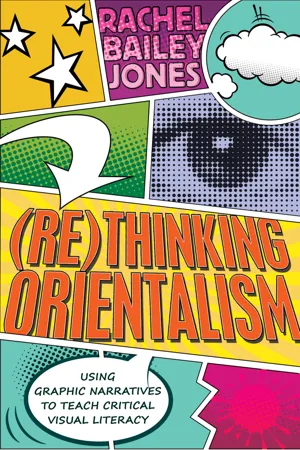
(Re)thinking Orientalism
Using Graphic Narratives to Teach Critical Visual Literacy
- 238 pages
- English
- PDF
- Available on iOS & Android
(Re)thinking Orientalism
Using Graphic Narratives to Teach Critical Visual Literacy
About this book
(Re)thinking Orientalism is a text that examines the visual discourse of Orientalism through the pedagogy of contemporary graphic narratives. Using feminist, critical race, and postcolonial theoretical and pedagogical lenses, the book uses visual discourse analysis and visual semiology to situate the narratives within Islamophobia and neo-Orientalism in the post-9/11 media context. In the absence of mainstream media that tells the complex stories of Muslim Americans and Muslims around the world, there has been a wave of publications of graphic narratives written and drawn from various perspectives that can be used to create curriculum that presents culture, religion, and experience from a multitude of perspectives. The book is an accessible, upper level undergraduate/graduate level text written to give readers insights into toxic xenophobia created through media representation. It provides a theoretical foundation for students to engage in critical analysis and production of visual media.
Frequently asked questions
- Essential is ideal for learners and professionals who enjoy exploring a wide range of subjects. Access the Essential Library with 800,000+ trusted titles and best-sellers across business, personal growth, and the humanities. Includes unlimited reading time and Standard Read Aloud voice.
- Complete: Perfect for advanced learners and researchers needing full, unrestricted access. Unlock 1.4M+ books across hundreds of subjects, including academic and specialized titles. The Complete Plan also includes advanced features like Premium Read Aloud and Research Assistant.
Please note we cannot support devices running on iOS 13 and Android 7 or earlier. Learn more about using the app.
Information
Table of contents
- Cover
- Table of Contents
- Chapter One: Introduction: Bringing Theory to Practice
- Chapter Two: Situating the Discourse: Orientalism and Islamophobia
- Chapter Three: Visualizing Difference, Decoding Representation
- Chapter Four: Post-September 11th and the Visual Regime
- Chapter Five: Muslims in the American Media: The Muslims I Know, All-American Muslim, and Graphic Representations
- Chapter Six: From the Inside/Outside: Persepolis, Nylon Road, and A Game for Swallows
- Chapter Seven: Graphic Narratives from Inside the Iranian, Egyptian, and Tunisian Protests: The Tunisian Awakening, Rise, Zahra’s Paradise, and Qahera
- Chapter Eight: Self-Reflexive Outsiders: The Waiting Room, The Photographer, and Palestine
- Chapter Nine: Habibi: The Outsider Looking In
- Chapter Ten: Graphic Narratives of Self and Other: American Born Chinese, Pyongyang, and Fun Home
- Chapter Eleven: Conclusion: Lessons of Critical Visual Literacy
- Bibliography
- Index